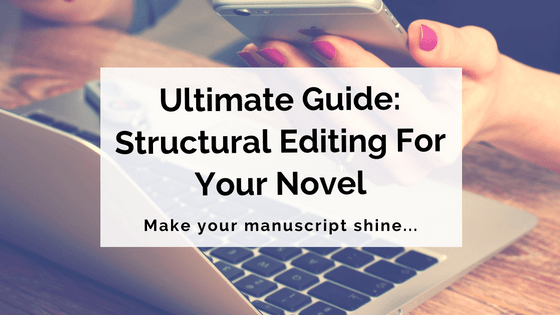If you’re an author who has finished a manuscript, chances are, you may have seen the term ‘structural edit’ floating around. Perhaps you’ve even been told to have an editor look over your book for ‘structural’ issues.
In this extensive guide, we’ll take you through: what is a structural edit, why your book needs one, and what you can do yourself to identify and address structural issues in your fiction.

What is a structural (or developmental) edit?
It may come as a surprise to those of you who are new to the industry, but there are actually three different types of editing: structural (or developmental) editing, copy editing (also sometimes called line editing), and proofreading.
For more information on the novel editing process as a whole, check out our epic guide: How To Edit Your Novel: The Ultimate Crash Course.
In this article, our focus will be the structural edit.
The structural edit is the process that comes first, after a manuscript is completed. It involves looking at the ‘big picture’ elements of the narrative and characters, and examining which of these elements are working and which could be improved, cut or changed altogether.
A structural edit focuses on literary devices such as:
- Pacing: For example, is the narrative always moving forward? What parts of the story lag and slow the reader down?
- Character Development/Characterisation: Are the characters authentic? Do they have realistic motivations and relationships with one another?
- Plot: Is the plot plausible? Does it make sense? Are there any gaping plot holes that need fixing?
- Structure: Does the book start at the most appropriate part of the story? Could it be improved by starting elsewhere? Has the author used structural devices, like changes in perspective, that aren’t working?
- Writing Style: Does the style of writing suit the genre? Is the language overly flowery and verbose? Could you add more lyrical elements to the manuscript?
- Voice/Tense: Are the voice and tense authentic and consistent throughout the manuscript?
- Setting: Is there enough scene setting and world building for the reader to place themselves within the story?
These are just some of the questions a structural edit will pose.
A structural edit does not address issues of spelling and grammar; these changes occur in a copyedit after all the bigger structural issues have been identified and addressed.

Why does your book need a structural edit?
First things first, no matter how talented a writer you are, your manuscript is always going to need numerous revisions after you’ve finished the first draft.
The structural edit is the first stage of these revisions. It may even go through several structural edits, whether these are done by yourself or an editor.
A structural edit is essential for any manuscript for a number of reasons but mainly because while writing the story, you (as the author) have inevitably become too close to it.
Because you’ve been caught up in the actual writing of your book, it’s probably been a while since you’ve thought in-depth about the ‘big picture’ details.
Writing a book takes a long time, and you may have forgotten what you’ve included and omitted. You may have started down one track with a particular plot point and then it’s ended somewhere unexpected. You may have even gotten rid of a character whose name still crops up halfway through the book.
You may realise that you’ve completely forgot to describe the setting of an important place, or have described a location so much that it bores the reader.
A new manuscript is rife with inconsistencies and flaws, all needing to be addressed.
Your manuscript will be no exception. There is no doubt that it will contain structural issues, and/or issues with character development.
This is completely normal, and once you’ve got your head around these elements, it can actually be quite a liberating experience to go through and fix up each problem.
It will become clear quite quickly that your manuscript is on the road to becoming a fully fledged book!
Without a structural edit, authors will be left with plot holes, confusing scenes, underdeveloped 2D characters and a truckload of issues that will inevitably bring down the quality of their writing and the reader’s overall impression of their story.

Structural editing: What are the options?
So! For those of you looking to get started on the structural edit of your manuscript, there are a number of options available to you. Let’s take a look at them…
1. Do it yourself
We recommend that all writers have a go at doing their own structural edit before they get any beta readers or professional editors involved.
There’s no point in paying professionals just yet if you’re already aware of various issues that need fixing.
We’re not suggesting that you use the DIY option instead of using a professional, but rather in addition to.
You should be the first port of call. You need to get your manuscript to a point where you have done all you can to improve it, before approaching anyone else.
How to start your DIY structural edit…
1. Take some time away from your manuscript.
It sounds counter-productive at first, but remember – you’ve been immersed in this world for a long time that you’re probably not seeing it objectively.
Taking some time away from your novel will give you the distance you need to see the bigger picture.
2. While you’re in time-out, read other books in your genre.
Here’s your chance to really study the genre you’re writing in. Choose successful books in your genre and study them – these books have been professionally edited and published by established presses, so it’s really worth noting what makes their structural elements sing.
Can you apply any of this new knowledge to your own book? Examining these success stories should help you identify what’s not working in your own manuscript.
3. Read in a different format to how you wrote.
You most likely wrote your book on the computer, right? So when you read it for the first time in its completed form, change formats.
Put it on your Kindle or tablet, print it out on paper and read it how you would read any other book – curled up in your armchair, outside in the sun – whatever gets you in a ‘reader’s’ mindset.
4. Read it as a reader not a writer.
Remember that this reading time is all about the big picture details, so it’s important to have your ‘reader’s hat’ on. Try to enjoy your own book as you would any other title.
Ignore the small errors like spelling and grammar for now, and only jot something down when you notice a big issue – is there an inconsistency in the voice? Are the characters distinctive enough? Is there a section where you nodded off? Note these down to address later, and keep reading!
5. Make a ‘To Do’ list.
After you finish your initial read-through, what’s nagging you?
Off the top of your head, make a list of issues to fix – did a certain character bug you? Is there an unresolved plot point you forgot about?
There are undoubtedly problems in the book that you’re not happy with, so make a list of things you’d like to go through an address.

Ask yourself these questions…
For character development & motivation
- Are the goals and motivations of the protagonist clear?
- Are the characters authentic and three dimensional?
- Are the characters proactive about achieving their goals?
- Are the relationships between the characters well-developed and believable?
- Are the character’s voices distinct from one another, and consistent throughout?
For plot and pacing
- Are the stakes high enough to drive the tension throughout the narrative?
- Are the plot twists believable, yet unexpected?
- Do the characters react realistically to the events of the novel?
- Do the events unfold naturally, or are there events that jar or confuse the reader?
- Are there sections that lag or bore the reader?
- Does every scene drive the story forward?
- Are the hooks at the beginning and ends of each chapter effective?
- Does the book start and end in the most appropriate places?
- Is the story free of info-dumps that slow the action?
For setting
- Is the reader provided with a clear sense of place/location?
- Is the period of time, and the sense of time passing, clear throughout the manuscript?
- Are there sections where there could be more (or less) description of setting?
For voice
- Is the voice appropriate for the genre and target audience?
- Is the point of view the most appropriate and effective for the story that unfolds?
- Is the voice and tone consistent throughout the manuscript?
- Is the voice fresh and engaging?
[alert-announce]Learn more about how to edit and publish your book! Check out our new author courses here.[/alert-announce]

Once you’ve done your first structural edit, you may want to check out these 9 ways to sharpen your manuscript, before approaching a publisher.
2. Ask a beta reader
One of the most recommended options for authors trying to iron out structural issues in their novels is to pass their manuscript onto ‘beta readers’.
Beta readers are people who read your book in the early stages in order to tell you what’s working, what’s not and what they’d like to see more of.
These may be people from your local writing group, other writers or editors, or people who read your genre.
Beta readers are a really valuable source of feedback for writers at this stage in the editing process. They don’t need to be writers or editors themselves to pick up on details and elements of the manuscript that aren’t working, particularly if they’re regular readers of that genre.
Most authors who use beta readers for feedback use more than one, that way the author can start to see patterns emerging in feedback, and address these issues.

3. Get a professional editor
More and more authors these days are hiring professional editors to assist them with refining their manuscripts, whether this is before they self-publish or before they submit to publishers and agents.
If you’re an author looking to self-publish, hiring a professional is a must in our eyes, particularly at this critical point in the process.
It’s also a great option if you’re new to the industry and don’t have an established network of writer and reader friends to help you out.
You can hire a professional editor to do the following:
- A manuscript assessment/manuscript appraisal
- Structural edit of whole manuscript
A manuscript assessment is where a professional editor reads your entire manuscript and writes what’s called a ‘reader’s report’.
On average, this is around 3,000 words and is broken down into sections on specific elements (plot, pace, characterisation, etc.). Depending on the editor and service they’ve outlined, they may provide additional email or phone support.
Manuscript assessments can range between $500 and $2,000, depending on your editor, their experience, the turnaround time, and the word count of your novel.
A complete structural edit is generally more detailed than a manuscript assessment, and works specifically on the manuscript itself, making suggestions throughout using Track Changes and comments. The editor may also provide a report and email/phone support.
Prices for structural editing vary, and can be priced per word, or per page.
Writer’s Edit offers a range of editorial services, which you can check out here. Our editors also provide a variety of editing options, contact us here for inquiries.
***
Whether you choose to DIY, get the help of beta readers or hire a professional, the structural edit of your novel is an essential step before pursuing the publication of your novel.
Have you had your manuscript assessed? Have you already read through your book for structural issues? Tell us about your experiences in the comments below!
Happy editing!
7 responses to “Ultimate Guide: Structural Editing For Your Novel”
As good a description as I have seen, clear and uncluttered.
This was perfect!
I’m letting my novel rest for a few weeks so I’m trying to research the editing phase. This post on structural edits was exactly what I needed. Thank you!
Hey Andy,
Thanks for commenting! I’m so glad you found my article useful. I find structural edits the most challenging part of the writing/publishing process, so I’m happy I was able to shed some light for someone else!
Happy writing 🙂
– Helen
Excellent guide, very clear and simple layout.
As above, exactly what was needed- am at that stage.
Thank you!
Glad you found it useful, Bret! Happy editing!
I’m about to start editing my novel and this is the most clear article I’ve read on how to get started, so thank you! Let the editing begin! xx
I would recommend both a writing critique and beta readers for the editing process once a manuscript draft is completed and ready for a workshop.
I divide a writing critique into the details of craft elements to a story (by fellow writers) and beta reading from a reader’s perspective.
Then I hire a professional editor for the final and third revision.
Otherwise, some of these tips are quite helpful.